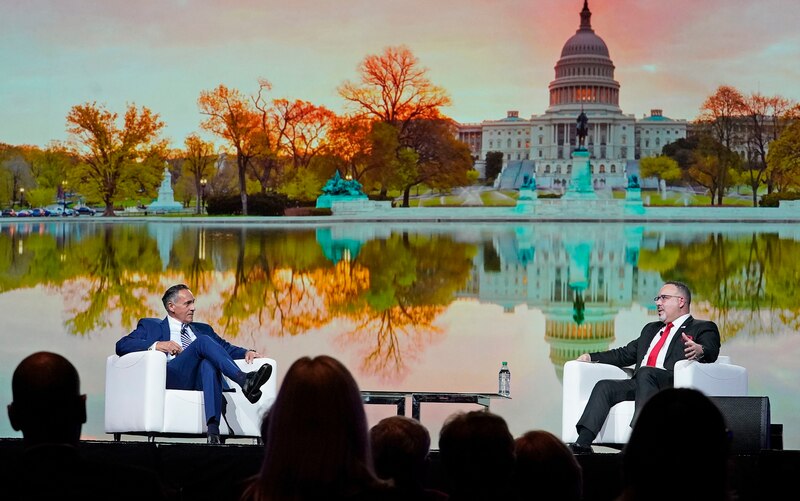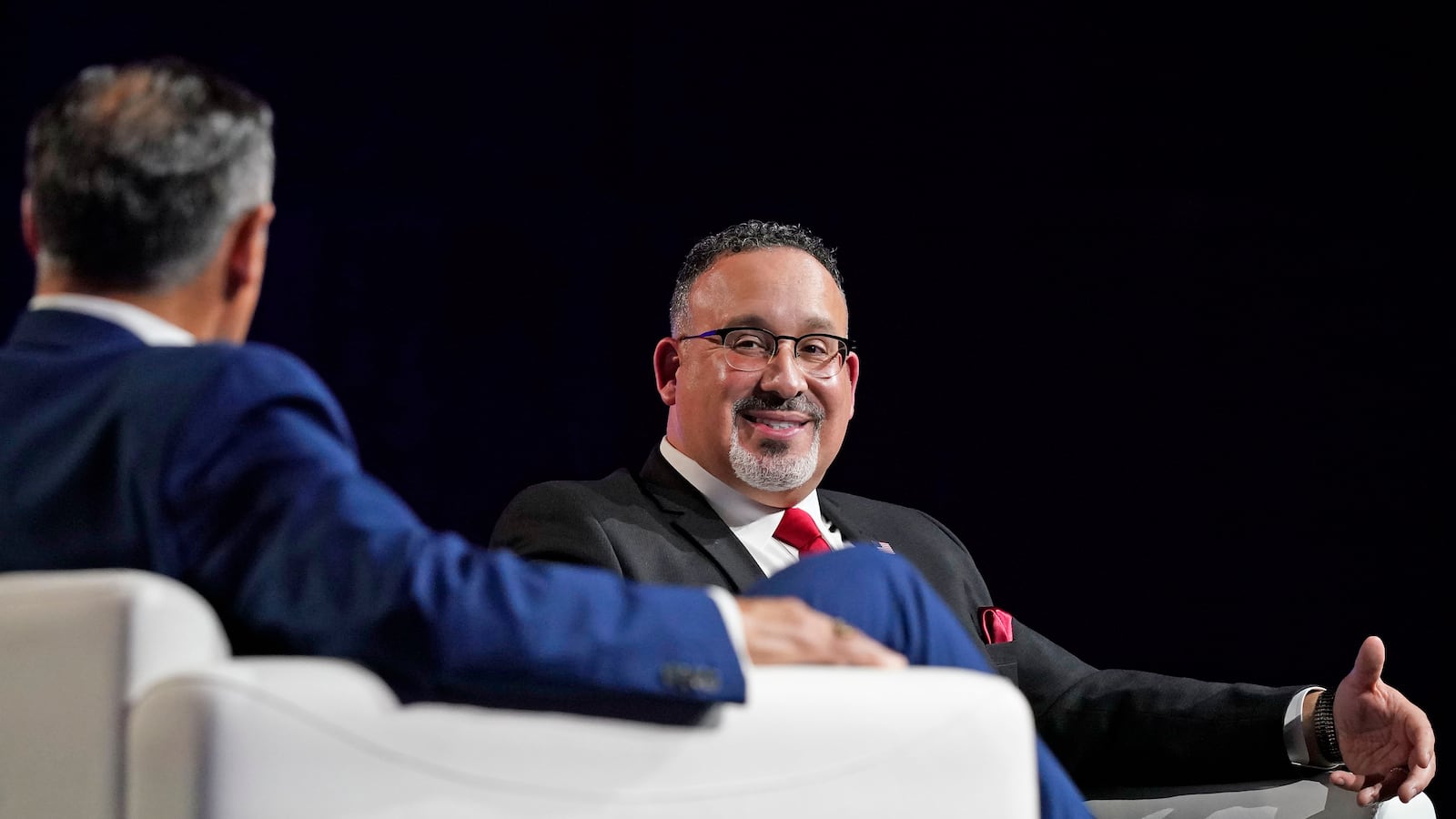When MaKenzie Mosby reflects on the four years she taught seventh-grade math, her feelings are mixed.
She loved her students, families, fellow teachers and staff at her Memphis charter school — and still does. But from the start of her career, even before the pandemic upended education, it became increasingly clear to Mosby that, for her, the profession wouldn’t be sustainable.
This is not only a problem in Memphis. Retaining teachers like Mosby and the thousands of other exhausted professionals across the nation who have left the education field was top of mind for U.S. Secretary of Education Miguel Cardona and the approximately 4,000 school leaders and industry professionals who discussed solutions at the School Superintendents Association’s National Conference on Education Thursday and Friday in Nashville. The conference wraps up on Saturday.
Asked about his big message to superintendents and all other educators, Cardona’s response was immediate: “Thank you.” He heralded educators’ heroic efforts throughout the pandemic, and encouraged school leaders to create work environments where teachers can thrive.
While the mental health of students has been a national focus recently, the mental health of educators is an under-discussed issue, said many at the conference. A 2021 survey by the RAND Corporation found that teachers are nearly twice as likely as other employed adults to experience frequent job-related stress, and they’re almost three times more likely to experience symptoms of depression.
“It’s important to remember that not only have our students suffered pandemic trauma — our educators have, our principals have, too,” Cardona said. “How awesome would it be if, when we reopen, we reimagine our schools and we think about the whole educator?”
‘Never-ending work day’ and expectations to ‘do everything’ drives teachers away
An inability to have work-life balance was part of what made Mosby leave teaching after four years. From the endless lesson planning and grading to the emotional labor that comes with supporting students through traumatic experiences stemming from poverty, gun violence, or racism, Mosby quickly burnt out.
Now working toward her master’s degree in public policy in education at Vanderbilt University, Mosby hopes she can be part of the solution. During her education history class this semester, Mosby has been encouraged to learn that teachers were, at one time, well-respected, well-paid, and not expected to “do everything.” With a change of mindset, Mosby has hope that can happen again.
With many schools lacking enough nurses and counselors, teachers are often left to pick up the slack. A 2021 study of the nursing workforce estimated that about a quarter of schools don’t have a nurse. And although the American School Counselor Association recommends one counselor for every 250 students, the national average as of the 2020-21 school year is one counselor for about 427 students.
“I just couldn’t do it anymore. It shouldn’t have to be that way,” Mosby said last month. “My kids mean so much to me, my school community means so much to me, the people I taught with mean so much to me. … Leaving was an incredibly difficult decision.”
Already struggling, state and local public education employment fell by nearly 5% overall since the beginning of the pandemic — and by almost 7% among just K-12 teachers — according to a recent Economic Policy Institute report. And in January, a National Education Association poll revealed that more than half of the members in the nation’s largest teachers union are considering leaving teaching sooner than they had originally planned. In addition, about 90% of members called burnout a “serious problem.”
There are many reasons Toria Howard left teaching after a 15-year career in the profession. Teaching at a number of schools across Memphis throughout her career, Howard never felt she had autonomy in her own classroom. She often felt the curriculum she was required to use wasn’t engaging or relatable to her students, and she didn’t feel heard when she expressed concerns.
And beneath it all, she was exhausted from years of being overwhelmed, overworked, and underpaid. EPI research shows that public K-12 school teachers across the country are paid nearly 20% less than similarly educated workers in other occupations.
“It was a never-ending work day,” Howard recalled. “I’d have meetings before or after school, and then I’d have to come home and do more work — grading papers, making PowerPoints. And I didn’t get paid for that.”
After leaving her last job at M.L.K. College Prep High School, a part of the Memphis charter network Frayser Community Schools, Howard has never been happier. She became a real estate agent, and also educates adults about financial literacy. Still, she wishes she could have remained in the classroom.
“Betting on myself is the best thing I ever could’ve done for myself,” Howard said. “Teaching just didn’t work out for me.”

Cardona, superintendents discuss how to improve teacher retention and recruitment
The current issues with teacher retention have also drawn attention to the shrinking teacher pipeline across the U.S. Filling open positions has been a problem in U.S. schools for more than a decade: Between the 2008-09 and 2015-16 school years, the number of people graduating with education degrees decreased more than 15%, according to the EPI report.
This school year has been no exception. Last fall, 18 of 20 large U.S. school districts that provided data to Chalkbeat reported the number of teacher vacancies had increased this year.
Memphis-Shelby County Schools, the largest district in Tennessee with more than 100,000 students, reported having 200-plus teaching positions open in the fall, up from 63 last year, and across Tennessee, the number of new educators graduating from teacher training programs has dropped by nearly one-fifth over five years, according to a new report.
Chief of Human Resources Yolanda Finne Martin said this year has been the Memphis district’s hardest — but she has faith it will get better. The district has implemented new strategies to attract teachers, from offering signing bonuses and increasing marketing efforts to recruiting college students studying subjects outside of education like math or history early and hosting hiring fairs year round.
During the conference on Thursday and Friday, panelists offered many ideas for superintendents to make to attract high-quality teachers and administrators to their districts.
While schools can’t offer fully remote work or similar benefits many workers seek, Meenoo Rami, a former Philadelphia educator and author of “Thrive: 5 Ways to (Re)Invigorate Your Teaching,” suggested schools build in as much flexibility as possible. Rami said allowing staff to work four 10-hour days during summer prep or professional development weeks, adding a monthly mental health day, or late starts on Fridays could make a world of difference for overwhelmed staff.
But beneath it all, panelists urged school leaders to go beyond recruitment to build a strong school culture that teachers and other staff want to be part of because they feel supported and heard.
Tyler Vawser, vice president of marketing for Apptegy, a school marketing software company, said school leaders must create an environment where weary teachers can come to them with concerns when they’re having a bad day and offer feedback for how the school can be better. Being transparent and willing to own up to mistakes, he said, is also key.
“Perks are great, but that’s not what changes people’s experience day to day,” Vawser said. “It’s making sure your people feel like you have their back and you’re doing what you say you’re going to do.”
During his Thursday remarks, Cardona hinted that less complicated student loan forgiveness for teachers could be one way the federal government could encourage more people to enter the profession. Beyond that possibility, though, Cardona encouraged school leaders to empower their educators.
“Teachers know our students,” he said. “We have to listen to them and value their voice.”
Samantha West is a reporter for Chalkbeat Tennessee, where she covers K-12 education in Memphis. Connect with Samantha at swest@chalkbeat.org.

